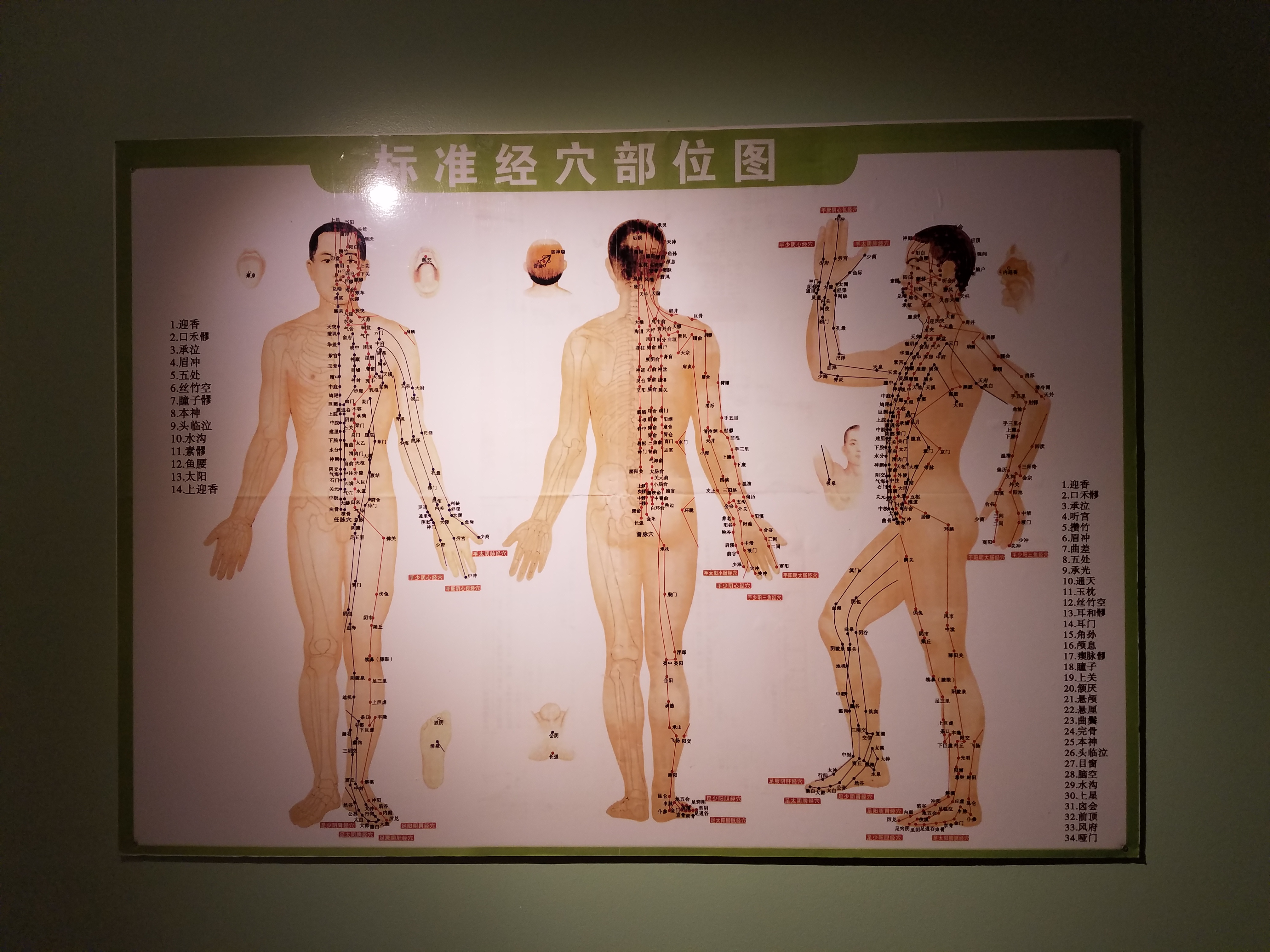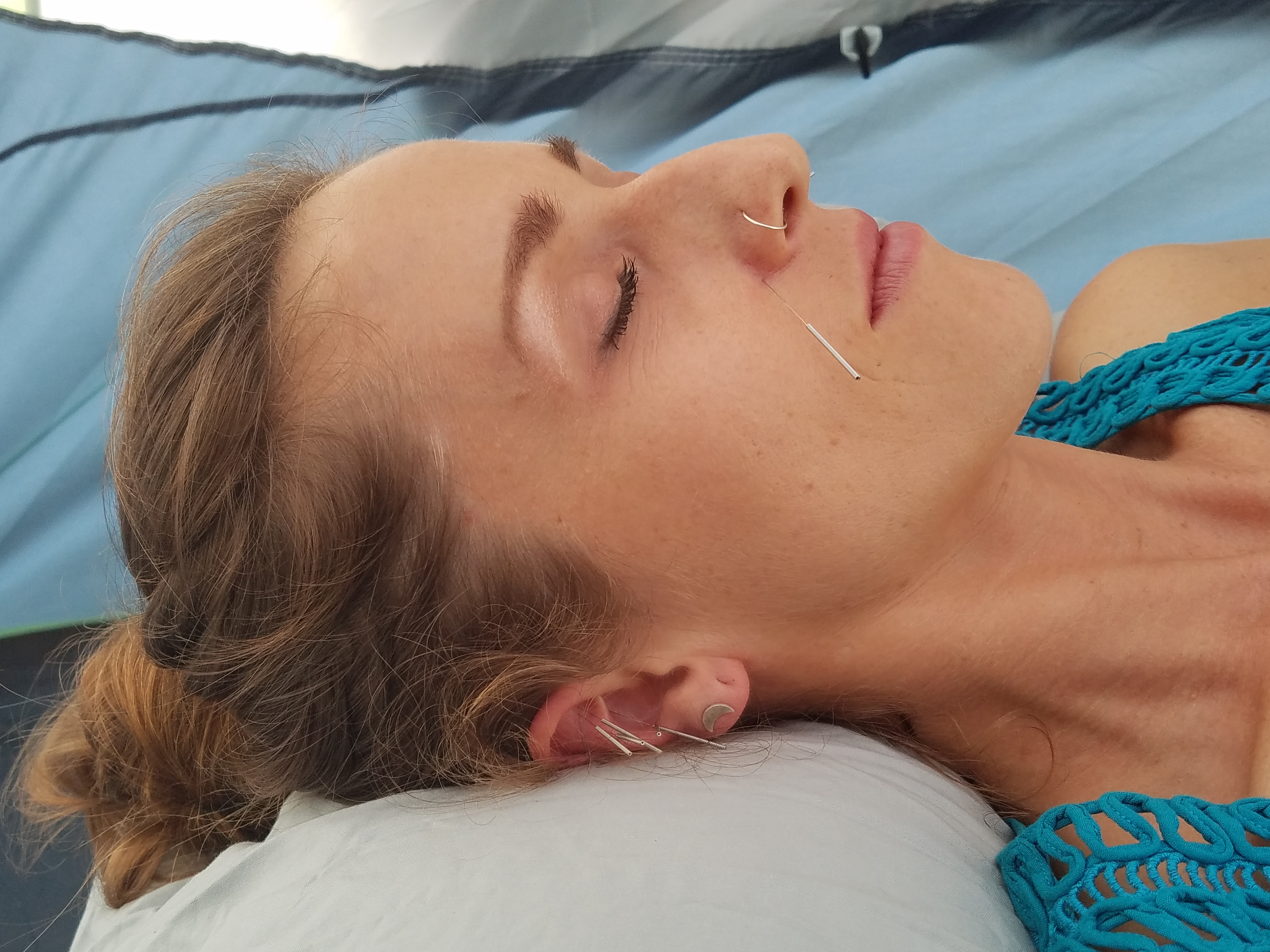Oriental Medicine for Injury Rehabilitation and Pain Relief
 By: Vanessa Vogel Batt, L.Ac., MSTOM
By: Vanessa Vogel Batt, L.Ac., MSTOM
After sustaining an injury, the healing process goes through two stages. The first is called the acute stage and is characterized by redness, swelling, inflammation and pain. The second is the chronic stage in which a patient may experience pain only when overusing the injured body part. Noticeable signs of inflammation may be nonexistent or minimal. In general, acute stages last from a few days to about three weeks, at which point any residual problems and pain are considered to have reached the chronic stage.
Physical trauma resulting from accidents, post-operative conditions, labor, disease or other causes requires different treatment for each stage of convalescence. Acupuncture and Oriental medicine provides comprehensive treatment from the very beginning of an injury all the way until recovery. To help rehabilitate a patient and provide pain relief after an injury, a practitioner may have to resolve a condition known as blood stasis.
Blood stasis, according to the theory of acupuncture and Oriental Medicine, occurs when the flow of blood slows down and blood begins to congeal. The pain associated with this condition is fixed, sharp and with clear boundaries. This means the pain does not change locations and can be located precisely by the patient. A good example of blood stasis is a bruise on the leg. Judging by the color changes on the skin, unpleasant sensations and perhaps some puffiness, it is evident the leg endured a physical trauma. All evidence points to an eruption of blood vessels resulting in a small, visible pool of blood.
For a patient contending with the aftermath of a broken ankle, getting back on one’s feet again may take a variety of therapies to assist in reversing the effects of blood stasis. In order to provide pain relief and help in regaining full mobility and range of motion in the foot, a combination of acupuncture, tui na and moxibustion may be utilized. Tui na is a Chinese form of medical massage and moxibustion, or moxa for short, is a heat therapy.
All three of these therapies can encourage the body to dispel blood stasis by decreasing inflammation and increasing blood circulation. Acupuncture points may be selected near the ankle to induce an immune response at the specific site of injury. Additionally, moxa may be employed to further stimulate this healing process through its curative heat and smoke.
Moxa is made from a dried form of the herb mugwort. A common form resembles a cigar. It is lit at one end and left to burn slowly. The moxa stick is placed near the skin and as the thick smoke and heat permeates into the body, it triggers an immune response. The warmth facilitates the easy, fluid movement of blood. After this portion of the treatment, tui na may be just the right adjunct therapy.
By applying tui na to the area surrounding the injury, blood circulation is further increased. Stiff muscles, along with underused tendons and sinews have a chance to revitalize. Although the massage may feel pleasant, its main purpose is to warm and stimulate blood flow. Not only can massage be applied near the wounded ankle but sometimes it is necessary to use tui na on the opposite leg. To compensate for the injured side, the healthy leg can become overused and require treatment as well, especially during the chronic stage.
https://www.acufinder.com/Acupuncture+Information/Detail/Oriental+Medicine+for+Injury+Rehabilitation+and+Pain+Relief
About the Author: Vanessa Vogel Batt, L.Ac., MSTOM, studied at the Pacific College of Oriental Medicine, and practiced acupuncture and Oriental medicine in New York for several years. Vanessa enjoys traveling the world, and has published articles on acupuncture and Oriental medicine and related health topics for websites and publications in both the U.S. and abroad.
Acupuncture Shows Promise in Cancer Treatment
“There have been many advances in the early detection and treatment of cancer. While the standard medical care for cancer is effective, the treatments are aggressive and cause numerous unwanted side effects as well as a lowered immune system. Acupuncture has received much attention as an adjunctive therapy in cancer treatments for its use in pain relief, reducing side effects, accelerating recovery and improving quality of life.
What Acupuncture is used for during Cancer Treatment
Acupuncture provides a total approach to health care for people with cancer. It can be used to address many of the concerns that come up during and after chemotherapy, radiation, biological therapy and surgery.
According to the National Cancer Institute, acupuncture may cause physical responses in nerve cells, the pituitary gland, and parts of the brain. These responses can cause the body to release proteins, hormones, and brain chemicals that control a number of body functions. It is proposed that, by these actions, acupuncture affects blood pressure and body temperature, boosts immune system activity, and causes the body’s natural painkillers, such as endorphins, to be released.
Areas that acupuncture has shown the most promise include:
- Nausea and Vomiting
- Dry Mouth, Night Sweats and Hot Flashes
- Stress, Anxiety and Fatigue
- Pain Management
- Increasing White Blood Cell Count
- Nausea and Vomiting
The strongest evidence of the effect of acupuncture has come from clinical trials on the use of acupuncture to relieve nausea and vomiting. Several types of clinical trials using different acupuncture methods showed acupuncture reduced nausea and vomiting caused by chemotherapy, surgery, and morning sickness. It appears to be more effective in preventing vomiting than in reducing nausea.
Other symptoms caused by cancer treatment
Clinical trials are studying the effects of acupuncture on cancer and symptoms caused by cancer treatment, including weight loss, cough, chest pain, fever, anxiety, depression, night sweats, hot flashes, dry mouth, speech problems, and fluid in the arms or legs. Studies have shown that, for many patients, treatment with acupuncture either relieves symptoms or keeps them from getting worse.
Boosting the Immune System
Human studies on the effect of acupuncture on the immune system of cancer patients showed that it improved immune system response, including increasing the number of white blood cells.
Pain Management
In clinical studies, acupuncture reduced the amount of pain in some cancer patients. In one study, most of the patients treated with acupuncture were able to stop taking drugs for pain relief or to take smaller doses.
Acupuncture is also very useful for support if you are undergoing chemotherapy, radiation, or hormonal therapy. Because chemotherapy and radiation therapy weaken the body’s immune system, a strict clean needle method must be used when acupuncture treatment is given to cancer patients.”
Study Confirms Acupressure Can Mitigate PMS Symptoms
By: Vanessa Vogel Batt, L.Ac., MSTOM
A 2017 study confirmed that women can self-apply acupressure to mitigate symptoms of premenstrual syndrome (PMS). Acupressure is an Oriental Medicine therapy that uses manual manipulation to specific areas of the body.
Researchers set out to discover if applying acupressure to the acupuncture points LIV3 and LI4 could influence depression, anxiety and physical symptoms associated with PMS. This particular combination of acupuncture points is widely used for a variety of gynecological issues. Additionally, the study participants were also evaluated for their overall quality of life.
LIV is an abbreviation of liver and large intestine. In this case, they both refer to the name of their respective channel. A channel is a line of healing energy, although invisible, constantly circulates in the bodies of all living beings. It is on these channels that acupuncture points reside, which practitioners of Oriental Medicine and acupuncture activate through the insertion of acupuncture needles.
The trial consisted of 97 participants who were divided into a control group and 2 experiment groups. The control group used placebo acupressure in place of real treatment. The experiment groups received treatment pertinent to their medical condition. One of the experiment groups utilized LIV3, while the other one used LI4.
The first round of acupressure was administered by a professional. The sessions were 20 minutes each and occurred every day for the 14 days before menstruation. During the next two menstrual cycles, the patients self-administered the same treatment they had during their first cycle. The study participants learned how and where to apply pressure on their bodies. Thus they continued the same routine of 20 minutes a day for 14 days, 2 weeks before their menses started.
With each cycle the women were asked to evaluate their emotional and physical symptoms, as well as state the general quality of their lives. At the end of the third cycle, researchers learned that women suffering from moderate to more severe symptoms of PMS, in both experiment groups, saw a statistically important reduction in them, when compared against the control group participants.
The quality of life for both of the experiment group patients also significantly improved as opposed to their counterparts in the placebo group. Researchers concluded that acupressure on either LIV3 or LI4 is effective for the treatment of physical and emotional issues related to PMS.
The study entitled, “The effect of applying pressure to LIV3 and LI4 on the symptoms of premenstrual syndrome: A randomized clinical trial,” appeared in the medical journal Complementary Therapeutic Medicine in April of 2017.
Source: Bazarganipour, Fatemeh, et al. “The Effect of Applying Pressure to the LIV3 and LI4 on the Symptoms of Premenstrual Syndrome: A Randomized Clinical Trial.” Complementary Therapies in Medicine, vol. 31, 2017, pp. 65–70., doi:10.1016/j.ctim.2017.02.003.
A Guide to Congestive Heart Failure
Congestive Heart Failure (CHF) can be a scary and confusing diagnosis. Congestive heart failure has a number of causes including heart attacks, infections, cardiac arrhythmias, high blood pressure and even genetics. Once you are diagnosed with congestive heart failure it is important to alter your lifestyle to limit the impact that the disease has on your health. You may be stuck with congestive heart failure, but it doesn’t have to define your life.
Let’s start at the beginning. What is Congestive Heart Failure?
The heart is a pump. Its job is to pump old non oxygenated blood from the body to the lungs so it can be oxygenated and then be pumped out so that each and every cell can be supplied. Congestive heart failure is the inability of the left side of the heart to pump an adequate amount of blood due to different factors. Because of this condition, the heart is weak and unable to pump all of its blood forward and some of it backs up to the lungs. This results in the lungs becoming congested with blood and fluid. Thus the name, “congestive” heart failure. This congestion makes the patient, feel short of breath. The more you exert yourself, the more oxygen the body requires and the less able the heart is to supply it. This is mainly the reason people may have a poor tolerance for activity if the CHF is not well controlled.
Heart failure, if left untreated, can cause damage to other important organs. Each and every tissue in your body requires a supply of oxygen and nutrients to do well. Your kidneys, your liver, your abdominal organs, and even your lungs must be supplied constantly with an adequate supply of oxygenated blood. If your heart is unable to deliver that oxygen rich blood those vital organs will begin to fail over time.
Additional Resources:
- An Overview of Heart Failure – Mayo Clinic
- Different Types of Heart Failure and Their Causes
- Overview of Heart Failure
Signs and Symptoms
Some of the signs and symptoms of heart failure may be easy to miss or to blame on other simpler issues. They include:
- Feeling tired more often and with less exercise
- Experiencing shortness of breath with less and less exertion
- Unexplained weight gain – especially the appearance of being bloated, this is called “edema”
- Cough without the presence of a cold or sinus infection, along with traces of blood in the saliva
Resources to help you recognize the signs and symptoms of heart disease:
- Recognizing Congestive Heart Failure
- Signs and Symptoms of CHF
- Signs, Symptoms and Causes of CHF in Children
What Treatments are Available for Congestive Heart Failure?
Most treatment options for congestive heart failure involve the use of various medications. A physician will work closely with you to find the perfect combination of medications that will help your heart work better and help with the demands of the body. Managing CHF requires a delicate balance between taking the work load off the heart and supplying enough oxygen and nutrients to the organs of the body. There are a couple of things you can do to make that job just a bit easier for your heart. We will discuss those a little later in the article.
There are invasive treatments for advanced congestive heart failure including heart transplantation and even the implantation of a pump that helps the heart push the blood along, but they are beyond the scope of this article. Let’s concentrate on some of the more common treatment options.
You may be prescribed a combination of the following medications to help with your heart failure.
- Anticoagulants – (commonly known as blood thinners) – they don’t actually “thin” the blood, but they prevent clots from happening. If your heart is not beating in an organized and strong manner, sometimes blood can remain in small pockets of the atrium and form blood clots. This increases your risk of stroke or blood clots in the lungs if they were to dislodge and travel there. If you are on a blood thinner you will most likely require regular blood tests to check your levels. You should be careful not to injure yourself and pay attention to symptoms that may indicate internal bleeding such as dark stools.
- Antiplatelet Agents – (Plavix) these medications also help with preventing blood clotting by inhibiting platelets that play an important role in forming them.
- ACE Inhibitors – Decrease the work that the heart has to do in order to pump blood around the body. They do this by dilating (widening) the blood vessels and decreasing the resistance that the heart has to pump against. They also help keep blood pressure under control.
- Beta Blockers – used to take the “workload” off of the heart. They slow your heart rate and decrease the strength of contraction to allow your heart to pump using less energy. These are used to control hypertension as well.
- Calcium Channel Blockers – used to decrease the work load of the heart. They are also used to control arrhythmias (irregular heart rhythms). The most common in congestive heart failure is atrial fibrillation.
- Statins – used to lower LDL (bad) cholesterol levels. They have also been shown to help raise HDL (good) cholesterol levels and lower triglycerides. All patients with any type of heart disease are generally prescribed a statin due to the fact that one of the forms of plaque formation is a direct cause of lipid acids.
- Digitalis Preparations – used to keep the heart rhythm regular with patients who have a problem with atrial fibrillation along with congestive heart failure. They are also used in advanced stages of the disease. Special care must be taken with the use of these medications due to its adverse effects.
- Diuretics – cause the body to excrete excess water. This prevents the heart from becoming overloaded and backing up into the lungs and causing symptoms of congestive heart failure, particularly shortness of breath. In addition, they prevent the build up of fluid and subsequent edema in the body such as the legs and ankles.
- Vasodilators (Nitroglycerin) – is given to reduce the amount of oxygen needed by the heart muscle and to dilate the coronary arteries to increase the amount of oxygen available to the heart muscle. This medication is particularly used to treat the pain of angina.
For more information regarding medications used to treat congestive heart failure:
- Heart Failure Treatment Guidelines
- Medicines for Congestive Heart Failure
- How Is Heart Failure Treated?
Since you will be taking multiple medications at multiple times during the day it is essential that you develop a system that works for you. Perhaps purchasing a pill box that you can fill once a week and use each day may help. It is imperative that you be 100% compliant with your medication regimen. Each medication is designed to not only to work with your body, but to also work with each other to maximize your heart’s ability to pump blood. It can be dangerous to take your medications at the wrong times or in wrong dosages.
Keeping your Heart Failure from Progressing
There are some relatively straight forward recommendations that may help keep your congestive heart failure at bay. The first we have already dealt with: 100% compliance with medication.
- Regular visits with both your PCP and your Cardiologist. Congestive heart failure must be monitored closely and any changes treated promptly. You should weigh yourself at least weekly and any 3lb or more weight gain should be reported to your physician. It may be the result of your body retaining fluid.
- Dietary Changes – If you are even slightly overweight, weight loss is imperative to prevent further damage to your heart muscle. The larger your body, the harder your already damaged heart has to work in order to supply much needed oxygen and nutrients. Even moderate weight loss can have a large impact on your congestive heart failure management.
- Exercise – can be a challenge because of the symptoms of congestive heart failure. However, any increase in activity is of utmost importance. Simple things like parking far away from the store instead of looking for the closest space. Walking is a great low impact exercise for patients with congestive heart failure. If the weather doesn’t cooperate, or you don’t have a safe, level place to walk, try the local shopping mall. Many malls open early and even place distance markers to be used by people who utilize the mall for exercise. It’s a great way to meet people, have some fun and stay healthy too! Just be careful not overdo it. You always have to consult your doctor before you start exercising and more so when have CHF.
- Avoid Fluid Overload – restricting fluid intake is important. Do remember, that the more fluid the heart is unable to pump forward, the more symptoms that will appear in the long run due to the amount of workload imposed. It only stands to reason that a decrease in fluid intake can reduce the amount of work the heart has to deal with.
- Salt Intake – where there is salt there is water. If you have a lot of salt in your body, you will retain fluid. It is important to avoid foods with high salt content and to refrain from salting foods.
- Smoking – Must be avoided at all cost. The smoke in cigarette carries a lot of carbon monoxide, this molecule worsens the ability of oxygen to be carried properly to the different tissues
- Stay healthy – it takes a lot of energy for your body to fight off everyday illnesses like the flu virus. Be sure to stay current on flu and pneumonia vaccinations. A respiratory disease may cause decompensation of your heart failure, so it’s not a good idea to take the risk.
Additional resources to help with healthy life style changes in patient with congestive heart failure:
Retrieved from https://www.acls.net/guide-to-congestive-heart-failure.htm
Treating Autoimmune Diseases with Acupuncture
Over 50 million Americans suffer from autoimmune disease including rheumatoid arthritis, lupus, thyroid disease, Addison’s disease, pernicious anemia, celiac disease, multiple sclerosis, myasthenia gravis and Guillain-Barré syndrome. An autoimmune disease occurs when the body’s immune system attacks healthy tissue. Due to the complexity of treating autoimmune disorders, integrative medicine solutions including acupuncture and Oriental medicine have received much attention as successful treatment therapies. Acupuncture is specifically noted for its use in pain relief, regulating the immune system, managing symptoms, and improving quality of life.
What Causes Autoimmune Disease?
Under normal conditions, an immune response cannot be triggered against the cells of one’s own body. In certain cases, however, immune cells make a mistake and attack the very cells that they are meant to protect. This can lead to a variety of autoimmune diseases. They encompass a broad category of over 100 diseases in which the person’s immune system attacks his or her own cells and tissue.
The exact mechanisms causing these changes are not completely understood, but bacteria, viruses, toxins, and some drugs may play a role in triggering an autoimmune process in someone who already has a genetic (inherited) predisposition to develop such a disorder. As the disease develops, vague symptoms start to appear, such as joint and muscle pain, general muscle weakness, rashes, low-grade fever, trouble concentrating, or weight loss. Numbness and tingling in hands and feet, dry eyes, hair loss, shortness of breath, heart palpitations, or repeated miscarriages may also indicate that something is wrong with the immune system.
How Acupuncture and Oriental Medicine Treats Autoimmune Disorders
According to Oriental medicine, autoimmune disorders occur when there is an imbalance within the body. Imbalance can come from an excess or deficiency of Yin and Yang that disrupts the flow of Qi, or vital energy, through the body. Acupuncture is used to help the body restore balance, treating the root of the disorder, while specifically addressing the symptoms that are unique to each individual.
Clinical research has shown that acupuncture causes physical responses in nerve cells, the pituitary gland and parts of the brain. These responses can cause the body to release proteins, hormones and brain chemicals that control a number of bodily functions. Acupuncture affects blood pressure, body temperature and immune system by these actions.
In addition to acupuncture, a treatment program to manage your autoimmune disorder may involve a combination of therapies, including stress reducing exercises, moderate physical activity, herbal medicine, nutritional support and bodywork.
To learn more about how acupuncture can safely and effectively be incorporated into a treatment plan for an autoimmune disorder, please call for a consultation today.
Study Finds Acupuncture Effective for Systemic Lupus Pain
Acupuncture can be an effective treatment for pain caused by systemic erythematosus lupus (SLE). These positive results were shown in the 2008 study ‘Acupuncture for Systemic Lupus Erythematosus: A pilot study RCT feasibility and safety study’ published in Sage Journals which assessed the safety and effectiveness of acupuncture as a means to treat pain associated with lupus.
At the end of the trial, 40% of the patients in both the standard acupuncture treatment group and the minimal needling group experienced an improvement in their pain levels of at least 30%. In contrast, the group that remained on their usual care plan reported no improvement in their pain levels. The study concluded that acupuncture is a valid, safe and effective method to treat pain in patients with SLE.
Source: Greco, C., A. Kao, K. Maksimowicz-McKinnon, R. Glick, M. Houze, S. Sereika, J. Balk, and S. Manzi. “Acupuncture for Systemic Lupus Erythematosus: A Pilot RCT Feasibility and Safety Study.” Lupus 17.12 (2008): 1108-116. Print.
Relief from Raynaud’s Syndrome Symptoms
Raynaud’s syndrome, also known as Raynaud’s disease, causes a sudden constriction of the vessels supplying blood to the skin, largely affecting the fingers and toes. The symptoms, commonly known as an attack, may be triggered by cold temperatures or emotional stress. Most cases are mild and can be treated with lifestyle changes such as wearing warm gloves and socks, and avoiding rapid temperature changes. While not life-threatening, in rare cases, when left untreated, the affected tissue may become necrotic and gangrenous.
According to a small 1997 study published in the Journal of Internal Medicine, acupuncture is effective in treating primary Raynauds syndrome. The patients that received acupuncture experienced a statistically significant decrease in the frequency, severity and duration of their vasospastic attacks. The patients in the control group showed no improvements. Researchers concluded acupuncture was safe and effective for treating the symptoms of primary Raynaud’s syndrome.
As a cold environment or object is often responsible for triggering an attack, this may indicate a Yang deficiency. When Yang energy is low, blood circulation may slow down as a result. Symptoms of Yang deficiency include feelings of cold, lower back or knee pain and a weak pulse. Treatment in this case would focus on boosting Yang energy, circulation and the immune system.
Source: http://inm.center/treating-autoimmune-diseases-with-acupuncture/
Electroacupuncture releases stem cells to relieve pain, promote tissue repair, study finds
Their findings, published online March 16 in the journal Stem Cells, provide the most comprehensive picture yet of how electroacupuncture stimulates the brain to facilitate the release of stem cells and adds new insight relating to the cells’ healing properties.
Electroacupuncture is a form of acupuncture that uses a small electrical current to augment the ancient Chinese medical practice of inserting fine needles into the skin at pre-determined points throughout the body.
For the study, a team of more than 40 scientists at institutions in the United States and South Korea was led by four senior authors including IU School of Medicine’s Maria B. Grant, MD, Marilyn Glick Professor of Ophthalmology and co-corresponding author; Mervin C. Yoder, MD, IU Distinguished Professor, Richard and Pauline Klingler Professor of Pediatrics, associate dean for entrepreneurial research at IU School of Medicine, director of the Herman B Wells Center for Pediatric Research and co-corresponding author; and Fletcher A. White, PhD, Vergil K. Stoelting Chair of Anesthesia, professor of anesthesia, pharmacology and toxicology.
“This work is a classic example of the power of team science, where investigators in different institutions with specific expertise worked together to unravel the complexity of how electroacupuncture works to help the body respond to stressors,” said Dr. Yoder.
The researchers performed a series of lab tests involving humans, horses and rodents that follow the effects of electroacupuncture from the stimulus of the needle all the way to the brain, resulting in the release of reparative mesenchymal stem cells (MSCs) into the bloodstream.
Depending on the species, electroacupuncture led to activation of the hypothalamus—a part of the brain that controls the nervous system and involuntary bodily functions such as heart rate and digestion—within nine to 22 minutes. The stem cells were mobilized within two hours.
“The acupuncture stimulus we’re giving these animals has a rapid effect on neuroanatomical pathways that connect the stimulus point in the arm to responsive neurons in the spinal cord and into a region in the brain called the hypothalamus. In turn, the hypothalamus directs outgoing signals to stem cell niches resulting in their release,” said Dr. White, who is a neuroscientist at the Richard L. Roudebush VA Medical Center in Indianapolis.
The researchers found electroacupuncture treatments resulted in higher thresholds for injury-induced pain, as well as considerable increases in the presence of a type of collagen that promotes tendon repair and anti-inflammatory cells known to be predictors of faster healing time.
Dr. White said these findings could lead to new strategies for tissue repair and pain management related to injuries.
“We could potentially capture the MSCs from an individual’s blood following electroacupuncture and save the cells for future re-introduction in the patient post-surgery or to treat chronic pain due to an injury,” he said.
The horses used in the study had been injured during training for international dressage competitions, and the six people who took part were healthy volunteers, who still showed activation of their hypothalamus through brain imaging.
More information: Tatiana E. Salazar et al, Electroacupuncture Promotes CNS-Dependent Release of Mesenchymal Stem Cells, STEM CELLS (2017). DOI: 10.1002/stem.2613
Provided by: Indiana University
Acupuncture Can Ease Carpal Tunnel
Acupuncture can relieve wrist pain, and researchers have tracked the brain and nervous system changes that may help explain why.
Scientists randomized 80 people with mild or moderate carpal tunnel syndrome — pain caused by nerve compression at the wrist — to one of three groups. The first received acupuncture at the wrist and ankle. The second got acupuncture at the wrist alone. And the third received sham acupuncture, using “fake” needles near the affected wrist, as a placebo. Using functional M.R.I. and nerve conduction tests before and after the procedures, they measured the effect on brain and nerves.
 All three groups found relief from pain, but both of the true acupuncture groups showed measurable physiological improvements in pain centers in the brain and nerves, while sham acupuncture did not produce such changes. Improvement in brain measures predicted greater pain relief three months after the tests, a long-term effect that placebo did not provide. The study is in Brain.
All three groups found relief from pain, but both of the true acupuncture groups showed measurable physiological improvements in pain centers in the brain and nerves, while sham acupuncture did not produce such changes. Improvement in brain measures predicted greater pain relief three months after the tests, a long-term effect that placebo did not provide. The study is in Brain.
“What’s really interesting here is that we’re evaluating acupuncture using objective outcomes,” said the senior author, Vitaly Napadow, a researcher at Harvard. Sham acupuncture was good at relieving pain temporarily, he said, but true acupuncture had objective physiological — and enduring — effects.
“Acupuncture is a safe, low-risk, low side-effect intervention,” he continued. “It’s perfect for a first-line approach, and it’s something patients should consider before trying more invasive procedures like surgery.
Virtual Tour of Clinic
Acupuncture May Help Prevent Migraines
 For people with a certain type of migraine headache, regular acupuncture treatments may help reduce the frequency of these debilitating attacks, a recent study from China suggests.
For people with a certain type of migraine headache, regular acupuncture treatments may help reduce the frequency of these debilitating attacks, a recent study from China suggests.
Patients who suffered migraines without aura, and who received five true acupuncture treatments per week for four consecutive weeks had about one less headache per month than similar patients who got the same number of sham acupuncture treatments, researchers report.
“Acupuncture should be considered as one option for migraine prophylaxis in light of our findings,” the authors write in JAMA Internal Medicine.
About 18 percent of women and 6 percent of men in the U.S. suffer from migraine headaches in a given year, according to a 2001 study, making the condition a leading cause of disability.
Acupuncture is commonly used to treat migraines in China, however, studies of whether it works for migraine prevention have been inconsistent, the study team notes.
Ling Zhao of Chengdu University of Traditional Chinese Medicine in Sichuan, China, and colleagues recruited 249 adults who had an average of two to eight migraines without aura per month from three clinical centers in China.
For the study, participants kept track of their migraine headache frequency and severity for four weeks before being randomly assigned to receive true acupuncture treatment, sham acupuncture treatment or to be put on a waiting list for treatment.
People in both the true and sham acupuncture groups received 20 treatments with acupuncture needles and electrical stimulation, each lasting thirty minutes.
The true acupuncture group was treated at four acupuncture points thought to affect headaches and with enough electrical stimulation to elicit a “Deqi” sensation, which includes “soreness, numbness, distention or radiation that indicated effective needling,” according to the authors.
For the sham treatment, the needles were placed in areas not known to be acupuncture points and the deqi sensation wasn’t induced.
At 16 weeks, the number of migraines reported in the true acupuncture group fell by about three attacks per month, while people in the sham acupuncture group had two fewer attacks per month.
Among the study’s limitations, about 20 percent of the participants had previous experience with acupuncture, and it’s not known how many may have been able to guess whether their treatments were real or sham.
“Placebo response is strong in migraine treatment studies, and it is possible that the Deqi sensation . . . that was elicited in the true acupuncture group could have led to a higher degree of placebo response because there was no attempt made to elicit the Deqi sensation in the sham acupuncture group,” Dr. Amy Gelfand writes in an accompanying editorial.
Gelfand, a neurologist at the University of California, San Francisco, told Reuters Health that the placebo effect is interesting and important, especially in migraine studies, but she thinks about it differently as a researcher and as a clinician.
“When I’m a researcher, placebo response is kind of a troublesome thing, because it makes it difficult to separate signal from noise,” she said. But when she’s thinking as a doctor about the patient in front of her, placebo response is welcome, Gelfand said.
“You know, what I really want is my patient to feel better, and to be improved and not be in pain. So, as long as something is safe, even if it’s working through a placebo mechanism, it may still be something that some patients might want to use,” she said.
When a patient is interested in a treatment that may have a strong placebo effect, Gelfand added, “There’s a real checklist in my head, with safety being the first thing; and if it seems like it’s safe then I think about things like cost, because often these things are not going to be covered by insurance, but to a certain extent that’s the patient’s decision; and I think about time, because these treatments can be time-consuming.”
It’s a good idea to keep your doctor informed of any treatments that you’re using, be they over-the-counter supplements or non-pharmacologic behavioral treatments, she said.
“I think that that’s part of the picture, and as a provider, I like to know about all of those things. If for no other reason than it just helps me understand what kind of treatments my patient values and is looking for,” Gelfand said.
http://www.newsmax.com/t/health/article/775313?ns_mail_uid=58186744&ns_mail_job=1714212_02262017&s=al&dkt_nbr=ydnurkei%C2%A7ion&keywords=acupuncture-prevent-migraines&year=2017&month=02&date=23&id=775313&aliaspath=%2FHealth%2FArticle%2FArticleTemplate&oref=news.newsmax.com
